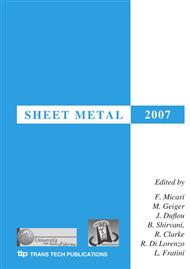p.317
p.325
p.333
p.341
p.349
p.357
p.365
p.373
p.383
Optimisation of the Stamping Parameters of a Drawn-Part Made of Stainless Steel
Abstract:
Demand for an increase in the useable properties of a drawn-part made of stainless steel has been the inspiration for the work. The use of 4H13 steel instead of 3H13 has resulted in the higher strength of the drawn-part but also a decrease in drawability. Therefore, some modifications to the original design of the sheet-metal forming process were necessary. A numerical simulation was applied to optimise of the stamping process. The ADINA System based on the finite element method (MES) was used. Frictional conditions on the contact surfaces, blank diameter and the course of the blank holding force versus time were analysed. In this paper, the test results of the mechanical properties of the analysed sheets (3H13 and 4H13 stainless steel) are given, some differences in the way of stamping drawn-parts made of these materials are discussed and the results of the numerical simulation are presented. A 3D model and perfectly rigid tool were assumed in the numerical model. The sheet was modelled using shell elements. The elastic and plastic properties of the sheet material were assumed and the frictional conditions on the contact surfaces were taken into consideration during the numerical simulation. Based on the numerical simulation the stamping process was optimised. A comparison between the numerical calculation and test results shows good convergence. Thanks to the MES analysis and the application of the new technological parameters, the desired drawn-part with the better useable properties was obtained.
Info:
Periodical:
Pages:
349-355
Citation:
Online since:
July 2007
Authors:
Price:
Сopyright:
© 2007 Trans Tech Publications Ltd. All Rights Reserved
Share:
Citation:


